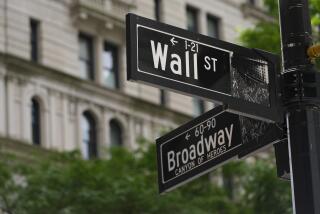The 401(k) Millionaires Club got smaller last year, with risk being the price of entry
- Share via
Fidelity Investments’ quarterly data dump arrived recently, featuring loads of information about its retirement-account holders. It was eye-opening, to say the least.
Last summer, we noted there was about $1 trillion in 401(k) and other retirement accounts. The estimates from Fidelity suggested that about 1 million people had more than $1 million in their 401(k) accounts; about 18% of those accounts were Fidelity clients.
Alas, that was then, when the market’s upward trend was still intact. Soon after, the fourth quarter arrived, bringing anguish as it wiped almost 20% of the value of the Standard & Poor’s 500 index. Many overseas markets had an even worse time. The pullback led some to speculate that the long string of gains dating from the end of the financial crisis almost a decade ago was in danger. The bull market, long in the tooth, according to some, was finally ending.
Given the hoopla over the 1 million 401(k) millionaires, Fidelity’s most recent update contains a fascinating tidbit: The number of people in that group fell by more than 28% in the fourth quarter. For Fidelity, about 50,000 of its account holders dropped out of the 401(k) millionaires club.
The market drop may have created lots of anguish, but it was also perfectly normal. Despite the fretting and hand-wringing, volatility is an enduring feature of stock markets, not some anomaly. I am not being glib, but rather, merely pointing out the obvious based on historical data.
Consider for a moment what the market would be like if all the angst-inducing declines, daily noise and emotional turmoil did not occur. What would exist in its place would be a placid, low-risk, low-return marketplace, where little of consequence actually happened. The overall trend would be modestly upward, with modest total returns. After all, returns are a direct function of risk, and risk itself is a function of the potential to generate less than your expected returns. Thus, with the lower likelihood of not getting what you expected, and less risk, returns would naturally be much lower.
A stock market with less volatility and smaller declines would look more like the government bond market than equity markets. We already have that, and the U.S. Treasury market serves a very different purpose for investors, providing a safe, modest return with minimal risk and a very high expectation of delivering on the nominal returns promised.
Treasuries do have some volatility; in some calendar years, the 10-year U.S. government bond has had declines of as much as 5%!
What the U.S. Treasury investor gets, besides the full faith and credit of the U.S. making good on that promise, are modest after-inflation returns, and much less price movement.
Again, this is by design.
As we discussed before, generating returns is a function of accepting, or even embracing, risk. The problem for most investors is that this induces a terribly trying emotional state. Evolution has created within us a desire to avoid most types of risk, lest we end up as someone else’s lunch — both metaphorically and literally. The risks we do embrace tend to be those that help the perpetuation of the species.
Optimism bias is a perfect example of this. Why else would 12 guys with sharpened sticks believe they could take down an enormous woolly mammoth? Sure, only eight came back, but those that did had meat and furs to survive the long, cold winter. The species continued, minus a few unfortunates.
Our relationship with risk has evolved over time and under very different circumstances from those we find in modern capital markets. We both need and fear risk if we want to achieve anything of value. This includes investor returns as well as the success of the species.
In other words, if investors want to avoid the sort of volatility we saw in the fourth quarter, they only have to give up much of the returns to get it. Anything else smacks of the illusory free lunch of getting returns without the risk.
Barry Ritholtz writes a column for Bloomberg.
More to Read
Inside the business of entertainment
The Wide Shot brings you news, analysis and insights on everything from streaming wars to production — and what it all means for the future.
You may occasionally receive promotional content from the Los Angeles Times.










